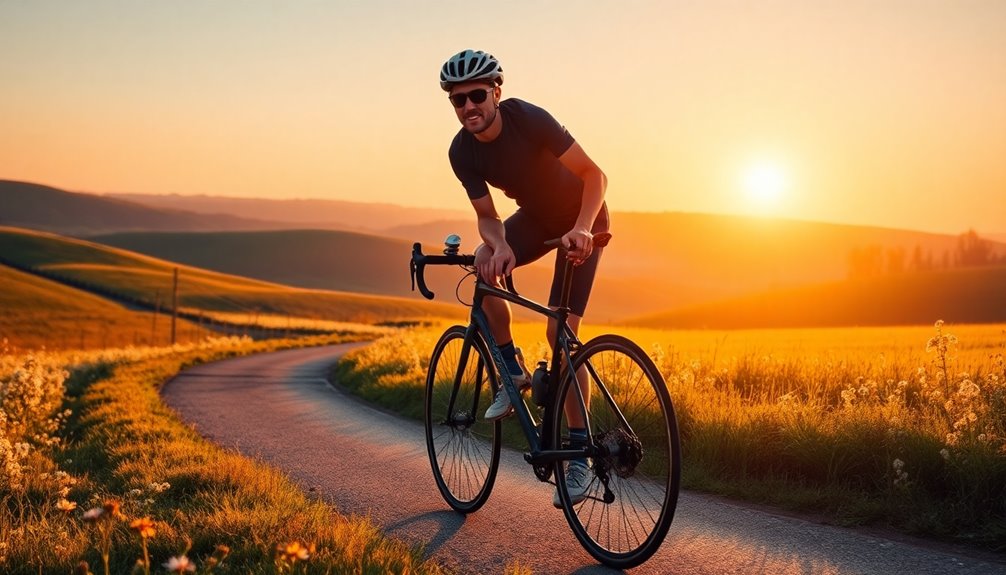Your day as a cycling enthusiast starts at dawn, hydrating and fueling up with the right breakfast for your ride. You tackle scenic routes, embrace fresh challenges, and connect with fellow riders along the way. Staying hydrated and well-nourished keeps your performance peak, while post-ride stretching aids recovery. As evening falls, you reflect on the day's adventures and look forward to the next journey. Keep going, and you'll discover even more about this exhilarating lifestyle.
Key Takeaways
- Early mornings start with hydration and a tailored breakfast to fuel the day's ride based on training intensity.
- Daily rides through scenic routes provide breathtaking views and varied terrain while fostering camaraderie among cyclists.
- Maintaining peak performance requires strategic hydration and nutrition, including 100 grams of carbohydrates per hour during rides.
- Engaging in community events, group rides, and social media connections enhances the cycling experience and builds lasting friendships.
- Post-ride recovery focuses on protein-rich meals, stretching, and adequate sleep to support muscle repair and overall fitness.
Early Morning Rituals
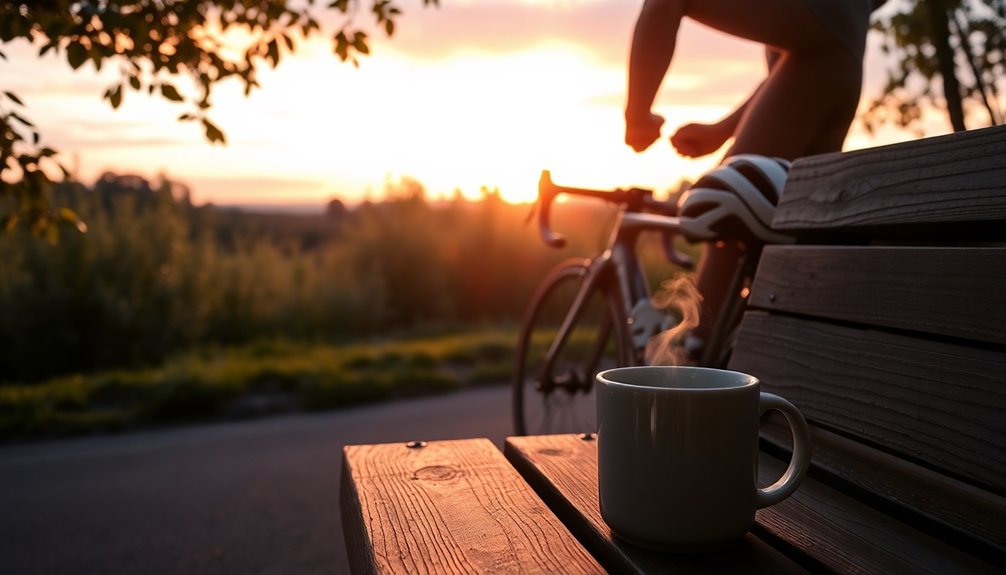
As the sun peeks over the horizon, many cycling enthusiasts rise early—often around 5 am—to carve out time for their daily ride.
These early morning rituals kick off with hydration; you're likely downing about 500ml of water to jumpstart your metabolism.
Next, you'll focus on breakfast, tailoring your meal to match your training load. If it's an easy ride, you might grab something light, but for tougher sessions, you'll opt for higher carbs to fuel your performance.
Breakfast is tailored to your training load; light for easy rides, and higher carbs for tougher sessions to fuel your performance.
With a structured routine, you commit to cycling 5-6 days a week, making it a non-negotiable part of your life.
Before heading out, you might even squeeze in some stretching or light bike maintenance to guarantee you're ready for the road ahead. Proper nutrition plays a crucial role in sustaining your energy levels and enhancing overall performance during your rides.
Preparing for the Ride

Before you hit the road, make certain you're well-hydrated and fueled up.
Check off your essential gear, from your cycling shoes to that weather-appropriate jacket, to guarantee a comfortable ride.
Taking these steps will set you up for a successful day on two wheels.
Hydration and Nutrition Tips
Starting your ride on the right foot hinges on proper hydration and nutrition. To kick off your day, drink at least 500ml of water upon waking. This helps combat dehydration and sets a solid foundation for your ride.
Tailor your pre-ride meal to the ride's intensity—opt for low-carb meals for easy rides and ramp up carbohydrates for tougher efforts. A great breakfast might include three poached eggs, smoked salmon, and salad, giving you sustained energy.
During longer rides, aim for about 100 grams of carbohydrates per hour, complemented with fats and proteins. Additionally, consider the importance of essential skin prep to protect your skin during outdoor activities.
Finally, post-ride, focus on protein and vegetable-rich meals to aid muscle repair while keeping carbs minimal for ideal recovery after high-intensity efforts.
Essential Gear Checklist
Packing the right gear can make or break your cycling experience. An essential gear checklist guarantees you're ready for any adventure. Here are three must-haves to include:
- A high-quality bike: The performance difference is incredible.
- A reliable helmet: Protects your most valuable asset—your head.
- Essential tools: They'll save you when unexpected issues arise.
Consider investing in proper cycling clothing too. Padded shorts and moisture-wicking jerseys enhance comfort on long rides.
Don't forget accessories like a cycling computer or GPS device for tracking your stats and charting routes. Additionally, investing in an electric bike conversion kit can elevate your cycling experience and expand your riding options.
With this essential gear checklist, you'll feel confident and prepared to tackle the road ahead. Enjoy the ride and the freedom it brings!
Scenic Routes and Challenges
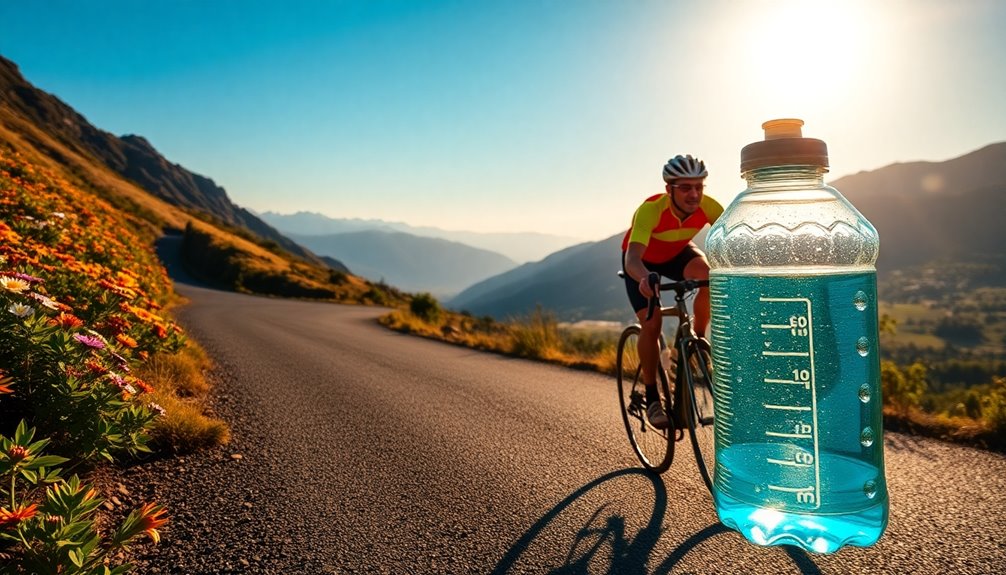
As you pedal through breathtaking landscapes, every turn reveals a new stunning view that makes the effort worthwhile.
Yet, maneuvering the challenges of varied terrain can test your skills and resilience, pushing you to grow as a cyclist.
Embracing these experiences not only enhances your ride but also strengthens your connection to the cycling community.
Breathtaking Views Awaiting Exploration
While you pedal along the stunning scenic routes, breathtaking views unfold before your eyes, inviting you to explore the beauty of nature.
Imagine gliding along the Pacific Coast Highway with the ocean's roar beside you, or conquering the Swiss Alps, where towering peaks challenge your spirit.
Cycling through national parks like Yellowstone, you'll witness unique wildlife and majestic landscapes that can take your breath away.
- Feel the wind in your hair as you embrace the thrill of discovery.
- Capture the moment when a sunset paints the sky with vibrant colors.
- Share stories of your adventures that inspire others to seek their own breathtaking views.
Each ride becomes a blend of physical challenge and mental rejuvenation, making every journey unforgettable.
Navigating Terrain Challenges Together
Maneuvering varied terrains can be both challenging and exhilarating, especially when you're surrounded by stunning landscapes. As you tackle steep hills and steer through gravel paths, you enhance your skills and boost your fitness levels.
Group rides are a great way to experience these challenges together; sharing tips and motivating one another creates a supportive atmosphere. You'll find that conquering difficult routes fosters camaraderie among fellow cyclists, turning strangers into friends.
Plus, steering through diverse terrains often leads to discovering hidden gems in both nature and urban settings. Each ride becomes a fulfilling adventure, where the beauty of your surroundings complements the thrill of the journey.
Embrace these challenges, and enjoy the ride!
Hydration and Nutrition Stops
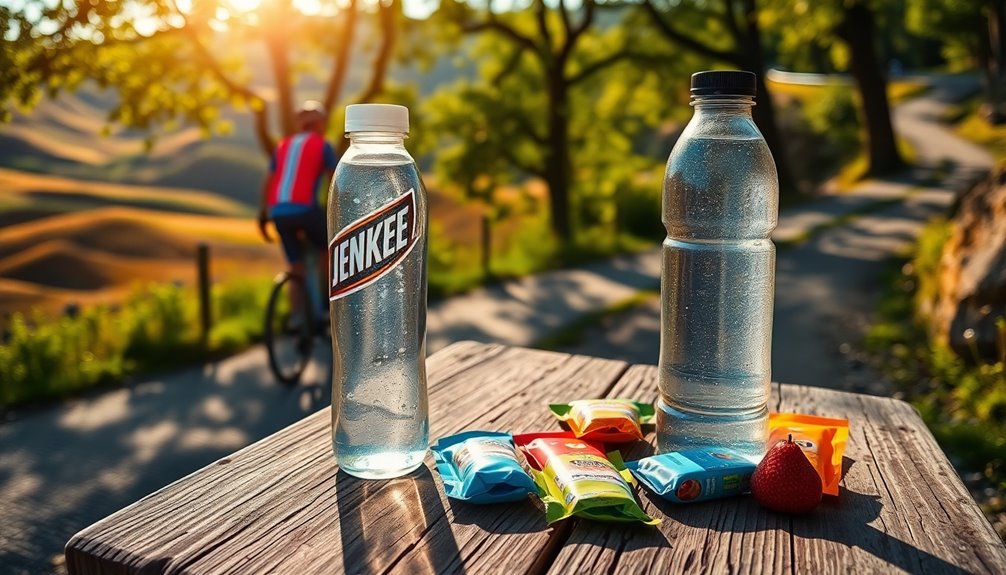
Hydration and nutrition stops are essential for maintaining peak performance during a ride, ensuring you have the energy needed to tackle even the toughest stretches.
You typically start your day by downing about 500ml of water, and during your ride, aim for around 100 grams of carbohydrates each hour.
Don't forget those strategic breaks—when a breakaway happens, it's the perfect time to hydrate and refuel.
- Feel the rush of energy as you sip invigorating water.
- Relish the taste of a well-deserved snack from your musette bag.
- Experience the joy of riding strong, knowing you're properly fueled.
Additionally, staying hydrated can help prevent ear pressure during colds, which is crucial if you cycle in varying weather conditions.
Connecting With Fellow Riders

After fueling up and rehydrating, the camaraderie of fellow riders adds an exhilarating dimension to your cycling experience. Connecting with fellow riders often happens through social media platforms and group rides, creating a sense of community and support.
Joining local cycling clubs or teams can enhance this bond, as members share training tips and personal stories. Participating in organized events like charity rides, centuries, and sportives allows you to meet new people who share your passion.
With an average cycling frequency of 4-6 days a week, these interactions build lasting relationships. Cycling communities celebrate inclusivity, welcoming diverse groups, including heavier riders, ensuring everyone enjoys the thrill of the ride together. Additionally, the rise of AI tools in content creation has made it easier to share experiences and connect with a broader audience.
Post-Ride Recovery

As you roll back into your driveway, the significance of post-ride recovery becomes clear. Your muscles have worked hard, and now it's time to help them heal.
Start with some gentle stretching to promote flexibility and reduce soreness. Hydration is essential—replenishing lost fluids will keep your performance at its peak. Remember to fuel your body; consuming carbohydrates and protein within 30 minutes aids muscle repair.
- Feel the relief of tight muscles loosening.
- Experience the satisfaction of nourishing your body.
- Embrace the energy that comes from proper recovery.
Incorporating rest days into your routine is important too. This allows your muscles to adapt and prevents overtraining, enhancing your overall cycling performance. Additionally, consider sipping on green tea post-ride, as it has been shown to enhance memory retention and promote relaxation.
Prioritize post-ride recovery, and you'll ride stronger tomorrow.
Evening Reflections
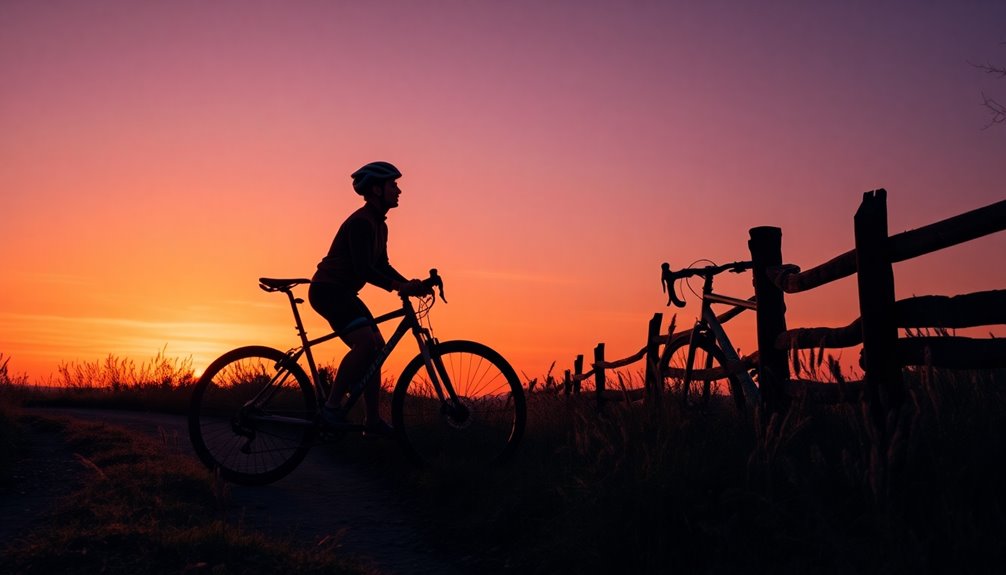
Evenings often bring a sense of calm, allowing you to reflect on the day's ride and the challenges you faced.
As you unwind, you might discuss race coverage with housemates or scroll through social media, fostering a strong sense of community among fellow cycling enthusiasts.
Your heart rate gradually lowers as you settle into this routine, reminding you of the effort you put in earlier.
You prioritize a nutritious evening meal, focusing on protein and vegetables to support your active lifestyle.
Stretching after your ride helps ease any tension, although you may skip foam rolling tonight.
With a solid commitment to recovery, you aim for around 9.5 hours of sleep, ensuring you're well-rested for tomorrow's adventures. Additionally, consider the importance of user control over data privacy as you engage with cycling communities online.
Looking Ahead to Future Rides

Looking ahead to future rides can be an exciting prospect, especially when you envision the various events you want to tackle. Each ride is an opportunity to challenge yourself and connect with like-minded individuals.
As you plan, consider:
- Participating in charity rides that support meaningful causes
- Tackling a century to push your limits and achieve personal milestones
- Exploring gravel events to discover new terrains and experiences
Setting a goal of 2,500 to 10,000 miles annually can keep you motivated.
Engage with local cycling communities and use apps to track your performance and find budget-friendly gear. Incorporating strength training and cross-training will enhance your fitness, ensuring you're ready for any challenge that future rides present.
Embrace the journey ahead!
Frequently Asked Questions
What Is the 80% Rule in Cycling?
The 80% Rule in cycling suggests that you should spend 80% of your training at an easy, conversational pace, while only 20% should be at higher intensities.
This approach maximizes your endurance and helps prevent burnout. By focusing on Zone 2 training, you'll enhance your aerobic capacity and improve fat utilization.
Following this rule not only boosts your performance but also reduces the risk of injury and keeps your cycling enjoyable and sustainable.
What Is the 75 Rule in Cycling?
The 75 Rule in cycling suggests you should aim to ride at least 75% of your weekly mileage at a moderate pace.
This approach helps you build endurance while improving your overall fitness.
Balancing high-intensity efforts with recovery rides is key to preventing injuries and ensuring adequate recovery.
Can You Lose Belly Fat by Cycling?
Ever wonder if cycling can really help you lose that stubborn belly fat? The answer is yes!
When you pedal regularly, you burn calories and create a calorie deficit, essential for fat loss. Aim for 5-6 sessions a week, and consider adding interval training to supercharge your results.
Not only does cycling work wonders for your cardiovascular health, but it also targets visceral fat, making it an excellent choice for a leaner midsection.
What Is the Average Lifespan of a Cyclist?
The average lifespan of a cyclist tends to be longer than that of non-cyclists, often by 5 to 10 years.
Regular cycling improves your cardiovascular health and lowers stress, contributing to this increased longevity.
Studies show cyclists have a 28% reduced risk of dying from cardiovascular diseases.
If you cycle just 30 minutes a day, you can greatly enhance your overall health, leading to a longer, happier life.
Conclusion
As the sun sets, reflecting on your day feels like flipping through a well-loved photo album, each ride etched in memory. You've pushed your limits, shared laughter with fellow riders, and soaked in the beauty of the trails. With every pedal stroke, you've not only chased fitness but also forged connections and created stories. Tomorrow holds new adventures, and the road ahead is as inviting as a favorite song. Embrace it, and keep cycling your way to joy!
